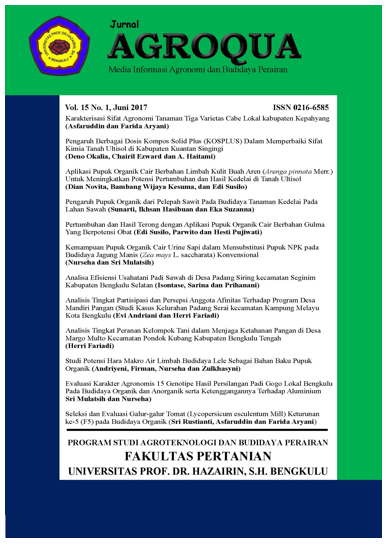RESPON ASAP CAIR TEMPURUNG KELAPA DAN PUPUK N, P, DAN K TERHADAP PERTUMBUHAN, FISIOLOGI PADI GOGO
Respon Asap Cair Tempurung Kelapa dan Pupuk N, P, dan K Terhadap Pertumbuhan, Fisiologi Padi Gogo
DOI:
https://doi.org/10.32663/ja.v19i1.1691Keywords:
Coconut Shell Liquid Smoke, N-P-K fertilizer, upland riceAbstract
The main problem of the minimum that inhibits crop growth, causing low productivity. (1) The study aims determine the effect of liquid smoke coconut oil on growth, of response upland rice physiology, (2) the study aims determine percentage of N, P, K fertilizer on the character of growthand response of upland rice physiology, (3) the study aims determine interaction the effect of variety and liquid smoke coconut oil, and percentage N, P, K fertilizer on the character of growth, and response of upland rice physiology. The research was conducted on April-September 2016 Cendana, Kutasari, Purbalingga. The design used was split – split plot with 3 replications. The main plot is upland rice varieties of Situ Bagendit, Inpago Unsoed 1 and Situ Patenggang. The Subplot is application of coconut shell liquid smoke without application concentration (0,5%), and (1%). The sub-subplot is the dosage of NPK fertilizer percentage of 0% NPK, 25% NPK, 50% NPK and 100% NPK. The variables observed were plant height, leaf number, number of tiller, leaf area, chlorophyll a, chlorophyll b, proline. The results showed that leaf area were significantly different in liquid smoke applications. Plant height, leaf size, chlorophyll b significant of NPK fertilizer.
References
Downloads
Published
Issue
Section
License
Authors who publish with this journal agree to the following terms:
- Authors grant the journal right of first publication with the work simultaneously licensed under a Creative Commons Attribution 4.0 Internasional (CC BY 4.0) Licence that allows others to use and share the work with an acknowledgment of the work's authorship and initial publication in this journal.
- The author(s) still hold the copyright of his/her/their work and retain publishing rights without restrictions such as (but not limited to) patent right, lecture, book and reproduce the article for own purposes.
















